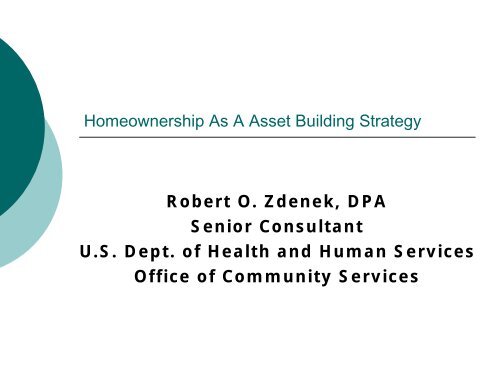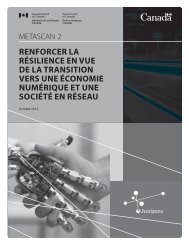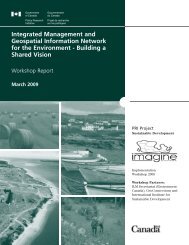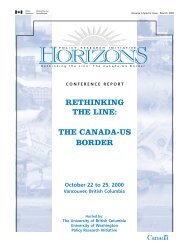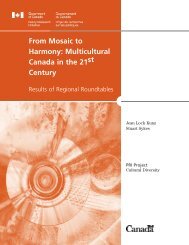Bob Zdenek
Bob Zdenek
Bob Zdenek
You also want an ePaper? Increase the reach of your titles
YUMPU automatically turns print PDFs into web optimized ePapers that Google loves.
Homeownership As A Asset Building Strategy<br />
Robert O. <strong>Zdenek</strong>, DPA<br />
Senior Consultant<br />
U.S. Dept. of Health and Human Services<br />
Office of Community Services
Homeownership As A Asset Building Strategy<br />
I. Overview and Introduction
Homeownership As A Asset Building Strategy<br />
Homeownership is a central goal of U.S. Social<br />
Policy- highest percentage of homeowners ever<br />
over 2/3 of American households<br />
Homeownership and asset building opportunities<br />
are fueled heavily through the U.S. taxcode.<br />
Michael Sherraden estimates, using 2000 data<br />
that:<br />
$75.2 billion for homeownership and<br />
$89.7 billion investments and business property.<br />
54% of the benefits went to homeowners with<br />
incomes over $100,000 and<br />
91% to homeowners with incomes over $50,000.<br />
This is out of a total of $288 billion
Homeownership As A Asset Building Strategy<br />
Our public sector response to housing<br />
both (rental and homeownership) is very<br />
categorical, fragmented and<br />
decentralized.<br />
Race and class have huge impact on<br />
homeownership and asset opportunity.<br />
Black Wealth and White Wealth written<br />
by Melvin Oliver and Thomas Shapiro<br />
documented that Caucasians had 11<br />
times the net wealth of Blacks (1987).
Homeownership As A Asset Building Strategy<br />
Much higher level of asset poverty in<br />
U.S. than income poverty. Haveman<br />
and Wolff define asset poverty as the<br />
ability to live at the poverty level for<br />
three months with income disruption.<br />
Income poverty was 12.6 percent in<br />
2000 and asset poverty was 25 percent.<br />
Real estate markets in many urban<br />
areas have exploded.
Homeownership As A Asset Building Strategy<br />
II. Capacity/Resources for<br />
housing and homeownership
Homeownership As A Asset Building Strategy<br />
A significant industry of communitybased<br />
development non profits (CBDOs)<br />
has emerged. The last national census<br />
in 1999 found that there were<br />
3600 CBDOs and that the total number of<br />
houses produced were<br />
550,000 with about 40% for homeownership.<br />
The vast majority of IDA initiatives as of<br />
2003 were sponsored by community-based<br />
non profits.
Homeownership As A Asset Building Strategy<br />
Federal housing resources tend to be either<br />
block granted through local and state<br />
government (Community Development Block<br />
Grant and HOME Investment) or in partnership<br />
with financial institutions such as the Federal<br />
Home Loan Bank System that has an Affordable<br />
Housing Program (AHP).<br />
Several regional FHLBB’s (New York, San<br />
Francisco, Kansas City) provide match funding<br />
for IDA initatives often called IDEA program at a<br />
3 to 1 rate up to $10,000.
Homeownership As A Asset Building Strategy<br />
Family self sufficiency funds-<br />
The U.S. Department of Housing and Urban<br />
Development (HUD) has an initiative for<br />
individuals living in public housing or who<br />
have Section 8 certificates under their<br />
voucher program.<br />
Individuals whose income increases while<br />
they are living in public housing or have<br />
Section 8 certificates can invest some of their<br />
excess income in escrow savings accounts<br />
that could be linked to a IDA program.
Homeownership As A Asset Building Strategy<br />
Community Reinvestment Act (CRA) and fair lending<br />
laws-<br />
This legislation was enacted in 1977 and requires<br />
that lending institutions who take deposits from a<br />
low income community are required to reinvest in<br />
those communities.<br />
Activists and community organizations can<br />
challenge financial institutions mergers and<br />
acquisitions where there is limited community<br />
reinvestment.<br />
Before tougher laws and regulations were enacted<br />
in the 1990’s, low and moderate income<br />
borrowers received only 19 percent of all home<br />
mortgage loans made in the U.S. By 2001, their<br />
share had surged to 28.4 percent.
Homeownership As A Asset Building Strategy<br />
National housing and community<br />
development intermediaries-<br />
National community development<br />
intermediaries (Local Initiative Support<br />
Corporation, Enterprise Foundation and<br />
Neighborhood Reinvestment Corporation)<br />
plus many regional and local intermediaries<br />
have been critical to the growth of affordable<br />
housing in the U.S. These intermediaries<br />
assemble financial resources, provide<br />
technical support and engage a wide array of<br />
stakeholders.
Homeownership As A Asset Building Strategy<br />
III. Issues and challenges<br />
for low and moderate<br />
income homeownership
Homeownership As A Asset Building Strategy<br />
Income and cost of housing- Hot<br />
real estate markets, especially on<br />
both coasts are making<br />
homeownership extremely<br />
challenging for low and moderate<br />
income citizens. IDA<br />
accountholders find that housing<br />
prices have escalated over 75%<br />
since they start saving.
Homeownership As A Asset Building Strategy<br />
Growth of predatory lending-<br />
The number of conventional lending<br />
institutions have declined significantly<br />
in low income communities and have<br />
been replaced largely by predatory<br />
lending practices—<br />
sub prime balloon loans, check<br />
cashing, pay day lending, refund<br />
anticipation loans (RALs).
Homeownership As A Asset Building Strategy<br />
Housing stock-<br />
Housing stock has aged in urban, innersuburban<br />
communities and rural<br />
communities. Many of the houses are over 50<br />
years old and with public subsidies declining<br />
there have been few units built even with the<br />
impressive growth of non profits.<br />
Affordable housing is being converted into<br />
market rate housing in neighborhoods once<br />
the government restrictions end.
Homeownership As A Asset Building Strategy<br />
Location and mobility of jobs-<br />
Regions have emerged as a major<br />
economic engine and job creator and<br />
these locations are often far from<br />
where large concentrations of low<br />
income and moderate income<br />
residents reside.<br />
Transportation is another barrier with<br />
a mediocre transportation system.
Homeownership As A Asset Building Strategy<br />
Race and class issues-<br />
It is more difficult for minority citizens<br />
and residents to be underwritten for<br />
conventional loans. More likely to be<br />
targeted for predatory lending<br />
practices
Homeownership As A Asset Building Strategy<br />
IV. Homeownership and asset<br />
building continuum and<br />
process
Homeownership As A Asset Building Strategy<br />
Start with financial education and<br />
credit counseling issues for<br />
homeownership.<br />
CSD found that with other factors<br />
consistent that up to 12 hours of<br />
financial education lead to a 22<br />
percent greater likelihood to deposit<br />
save (American Dream<br />
Demonstration- Sherraden)
Homeownership As A Asset Building Strategy<br />
Checking and savings accounts with<br />
direct deposit-<br />
Federal Reserve Board research shows that<br />
up to 30 percent of all Americans are<br />
unbanked.<br />
Importance of having mainstream banking<br />
including credit unions and other community<br />
development financial institutions (CDFIs).<br />
Direct deposit very important for savings as<br />
is refunds from Earned Income Tax Credits<br />
(EITCs)
Homeownership As A Asset Building Strategy<br />
Individual development accounts<br />
(IDAs) allow people to save and<br />
receive matched funds towards<br />
asset purchase.<br />
IDAs are sort of a mid-term<br />
strategy and tool in the asset<br />
accumulation process.
Homeownership As A Asset Building Strategy<br />
Asset specific support-<br />
Neighborhood Reinvestment Corporation and<br />
their local NeighborWorks organizations offer<br />
an excellent array of asset specific support<br />
for homeownership including<br />
homebuyer clubs (Manna pioneered this),<br />
pre-purchase and post-purchase training for<br />
future homebuyers.<br />
NRC supports over 70 homeownership<br />
centers (HOCs) throughout the U.S.—a onestop<br />
center for homeownership.
Homeownership As A Asset Building Strategy<br />
Asset purchase-<br />
importance of follow-up and postpurchase<br />
support and training. Asset<br />
preservation as an important goal of<br />
this.
Homeownership As A Asset Building Strategy<br />
V. Experience of IDA initiatives<br />
with homeownership
Homeownership As A Asset Building Strategy<br />
Assets for Independence Act<br />
(AFIA) is the largest single funding<br />
source for IDAs. We only have<br />
data for the first two years.
Homeownership As A Asset Building Strategy<br />
Over 50% of AFIA accounts<br />
opened have been for<br />
homeownership.<br />
5358 individuals have attended<br />
home purchase courses.<br />
151 purchased homes in first two<br />
years and withdrew $274, 629.
Homeownership As A Asset Building Strategy<br />
CFED completed a national survey<br />
of IDA programs with 192 program<br />
responses.<br />
7,931 individuals had completed<br />
asset purchase with 1,951 for<br />
homeownership and 744 for home<br />
repairs.<br />
Both figures represent one-third of<br />
total asset purchase.
Homeownership As A Asset Building Strategy<br />
VI. Concluding Thoughts
Homeownership As A Asset Building Strategy<br />
Asset building and continuum does<br />
work for moving low and moderate<br />
income people towards<br />
homeownership but it usually<br />
takes time.
Homeownership As A Asset Building Strategy<br />
Accelerated costs of<br />
homeownership is making it more<br />
difficult for IDA accountholders to<br />
achieve homeownership and there<br />
is an increasing shift of activity<br />
away from homeownership.
Homeownership As A Asset Building Strategy<br />
Importance of supply of decent<br />
affordable housing and the role of<br />
nonprofits in the U.S. and public<br />
sector in other countries.<br />
Asset specific support very<br />
important for homeownership<br />
opportunities


